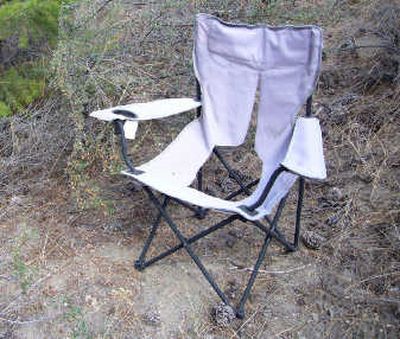Aquatic weeds, shoreline waste plague lake

FORT SPOKANE, Wash. – Bumper crops of weeds in the waters of the Lake Roosevelt National Recreation Area have prompted complaints from boaters and shoreline property owners.
The National Park Service is using steam heat, sun-blocking mats and other measures in an effort to prevent the weeds from clogging swimming areas, said Superintendent Debbie Bird, who took political leaders on a boat tour of the reservoir Friday.
After gliding over shallow bays where weeds have taken root, Bird diverted the tour to a camping spot on a beach, where she invited participants to walk ashore and view what she believes is a more pressing threat to the recreation area: human waste.
“Be careful, you guys,” Bird said, leading the group over the sandy beach flecked with piles of dog excrement. Tents were clustered at the back of the beach. Behind the tents was a narrow, brushy valley that had been used by campers as a toilet.
“Oh, my gosh,” said Sheila Stalp, a staff member from the office of Rep. Cathy McMorris Rodgers, R-Wash. “I can smell it from here.”
Participants walked into the valley cautiously, choosing each step. A camp chair with a round hole cut into its bottom was parked in a clump of sagebrush. Less than 20 feet away sat a bucket covered by a toilet seat.
“It’s disgusting,” Bird said. “That’s the only way to describe it.”
The base of nearly every bush was marked by a pile of waste. Strips of toilet paper fluttered from low branches.
Lincoln County Commissioner Deral Boleneus shook his head and said, “Guy’s gotta watch where he steps.”
“It’s like a barnyard,” replied Merrill Ott, a rancher and commissioner from Stevens County.
As the reservoir becomes more popular, the waste only gets deeper, commissioners said.
The scene is similar at dozens if not hundreds of makeshift campsites scattered along the shoreline of Lake Roosevelt, which stretches 129 miles through Eastern Washington. Shoreline campers are required to carry portable toilets, but many opt to use the sand instead, Bird said. This saves them the trouble of cleaning their toilet but leaves behind a stinking mess for the next camper, as well as a public health threat.
“It’s hard for me to get into the mentality of people who bring their families out and don’t think about what they’re leaving behind for the next family,” Bird said.
The Park Service is struggling to keep up with the mess left by the growing crowds, Bird said. Last year, about 1.5 million people visited the recreation area. Within a decade, the number is expected to jump to 2 million.
Meanwhile, the area has lost staff because of tight budgets. Eight full-time rangers patrol the recreation area – down from 20 a decade ago.
Bird thinks a permitting or registration system might be needed to control the problem. No decisions have been made. Bird said she simply wants to help local officials understand the problems facing Lake Roosevelt.
“It’s all going to take money,” she said. “Right now we’re stretched to the max.”
Along with the human waste, the recreation area is trying to find a way to prevent weeds from clogging shallow areas in the vast reservoir. Thick growths are a relatively recent phenomenon, said Ray Dashiell, chief of park maintenance. When Dashiell started working at the reservoir 41 years ago, the gates of Grand Coulee Dam had only been recently closed and the reservoir “was like a bathtub,” he said, with few fish or plants.
Sediment from the Columbia and Spokane Rivers has settled out in the water body, providing rich growing conditions. Lakes and rivers upstream have also become infested with Eurasian water milfoil, an exotic plant species that grows quickly and can form thick mats. A milfoil fragment no larger than a human hair can land in sediment and sprout.
“We will never be able to control Eurasian milfoil on Lake Roosevelt,” Dashiell said. “We would be kidding ourselves if we thought we could eradicate it.”
The Park Service recently installed black-mesh light barriers underwater at several popular swimming areas, including Porcupine Bay. The mats seem to be keeping weeds from growing, Dashiell said. The agency is also considering using herbicides in certain areas.
Continued drought and low winter snowpack in recent years have also boosted weed growth, according to an analysis by the Park Service. The reservoir level has been kept higher in winter to make up for the lost water later in the year. In the past, when the reservoir was drained deeper in winter to make room for melted mountain snowpack, aquatic weeds would be killed off by the open air and freezing temperatures.
Climate experts predict earlier loss of snowpack across the West because of global warming, which will likely mean fewer drawdowns for Lake Roosevelt and more aquatic plants, said Andy Dunau, executive director of the Lake Roosevelt Forum.
“It’s a good thing they’re trying to get a handle on it now because it’s not an aberration,” Dunau said of the Park Service’s efforts to control weeds. “You’re just going to see more and more of these years.”
But Todd Neel, a weed expert for the Park Service, said most of Lake Roosevelt’s plants appear to be native species, not milfoil. During Friday’s tour, he dragged an underwater rake across several weedy sites along the lakeshore. There were a few patches of milfoil, but mostly the rake came back loaded with the plants used by fish for breeding, food and cover.
“We need to weigh carefully where we remove aquatic plants,” Neel said.